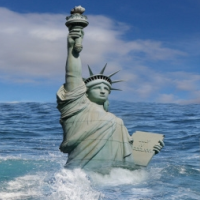Rising Sea Levels May Disrupt Lives of 13 Million Americans
 (photo: Getty Images)
(photo: Getty Images)
By Tatiana Schlossberg, New York Times
Sea-level rise, a problem exacerbated by greenhouse gas emissions, could disrupt the lives of more than 13 million people in the United States, three times more than most current estimates, according to a study published Monday.
Rising seas, which already endanger coastal communities through tidal floods and storm surges, could rise three feet or possibly even more over the next century if emissions continue at a high level, threatening many shoreline communities. The study, published in Nature Climate Change, argues that most projections vastly underestimate the number of people at risk because they do not account for population growth.
For the study, the authors combined future population estimates with predicted sea-level rise, using data from the National Oceanic and Atmospheric Administration, to demonstrate that millions are at risk: 4.2 million if seas rise by three feet; 13.1 million with a six-foot increase, a high-end estimate.
Mathew E. Hauer, one of the study’s authors and a doctoral student in geography at the University of Georgia, said, “We could see a huge-scale migration if we don’t deploy any protection against sea level rise.”
Recent studies have shown that the sea levels are rapidly increasing, probably at the fastest rate in 28 centuries, and its accompanying tidal flooding, increasingly frequent, is already causing headaches in low-lying places, especially in the American South. Though sea levels have risen and fallen dramatically in the past, scientists say they have been fairly constant for the last several thousand years.
Hauer and his co-authors also found a highly regional effect of sea-level rise. Of the projected population at risk, nearly 50 percent will be in Florida, and an additional twenty percent in other parts of the southeastern United States. In 30 different counties, more than 100,000 people would be at risk if the sea level was to rise by about 6 feet.
None of the 22 coastal states in the continental United States, as well as Washington, D.C., will be immune from the effects of sea-level rise, the authors predict. If the seas were to rise by about six feet by 2100, more than one million people in California, and almost as many in New York and New Jersey, would be affected, the study shows.
The researchers estimated that the cost of relocating the 13.1 million people displaced by sea-level rise would be about $14 trillion, based on relocation estimates for residents of Alaskan coastal villages.
Hauer said the study could be useful on a local policy level, as well.
Predictions for sea-level rise are often done on a very small scale while population forecasting is often done at a county or state level, Hauer said. Using census data, Hauer and his co-authors grouped units similar to city blocks to develop their forecast and assumed that housing development patterns would continue at the same rate.
Benjamin H. Strauss, an expert on sea-level rise at Climate Central, a climate change research organization, said he believed that the new study overstated the number of people at risk though he agreed that most estimates are too conservative.
The continuation of “current development patterns through the rest of the century seems like an unlikely future,” Strauss said, “because as sea levels continue to rise and coastal problems become glaringly obvious, coastal development and real estate will have to change.”
Strauss also said that this flooding model lacked some of the nuance shown in other studies on sea-level rise. Different parts of the country will see different levels of sea-level rise at certain moments in time, he said — coastal Louisiana and the Chesapeake region will see faster rates of change since the land there is also sinking, for example.
Another study published Monday in Nature Climate Change also highlighted the need for modeling that takes into account how different landscapes will react to sea level rise. The study, conducted by several members of the U.S. Geological Survey and a researcher from Goddard Institute at NASA, demonstrates that several ecosystems in the American Northeast, such as marshes and beaches, may adapt to sea-level rise, possibly undergoing formal changes, while developed or urban areas are more likely to flood or become submerged because of their hardened shorelines.
Erika E. Lentz, the report’s lead author, and a research geologist with the USGS, also said that most places would not see the degree of inundation predicted in Hauer’s study.
Hauer, a demographer, said that he was not making any predictions about the likelihood of certain sea-level scenarios, but was, instead, focused on the effects on people.
All three scientists acknowledged the degree of uncertainty in any of these forecasts."We don’t have anything to compare this to,” Hauer said. “We just don’t know how people are going to act.”
To Learn More:
Millions Projected to be at Risk from Sea-Level Rise in the Continental United States (by Mathew E. Hauer, Jason M. Evans and Deepak R. Mishra, Nature Climate Change)
Global Warming Sends Earth’s Sea Levels Rising Faster than Any Time in Past 2,800 Years (by Seth Borenstein, Associated Press)
Miami and New Orleans among 400 U.S. Cities said to be Doomed by Rising Sea Levels (by Noel Brinkerhoff, AllGov)
$40 Billion in U.S. Coastal Park Assets Are at “High Risk” from Rising Seas (by Ken Broder, AllGov California)
Scientists Predict 4 Million Americans will be “Significantly” Affected by Rising Sea Levels within 6 Years (by Noel Brinkerhoff and Steve Straehley, AllGov)
1,700 U.S. Cities Could Be Partially Underwater by 2100 Due to Climate Change (by Noel Brinkerhoff, AllGov)
- Top Stories
- Unusual News
- Where is the Money Going?
- Controversies
- U.S. and the World
- Appointments and Resignations
- Latest News
- Trump to Stop Deportations If…
- Trump Denounces World Series
- What If China Invaded the United States?
- Donald Trump Has a Mental Health Problem and It Has a Name
- Trump Goes on Renaming Frenzy






Comments